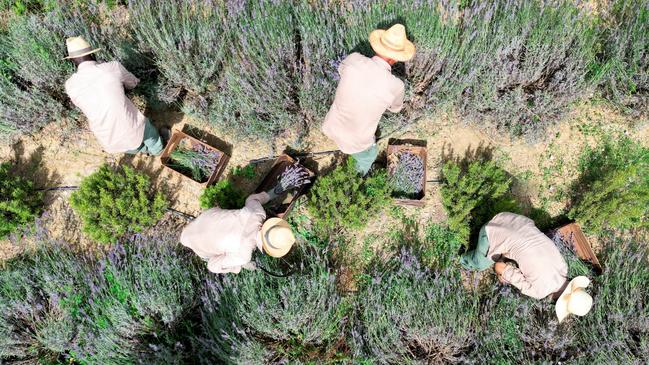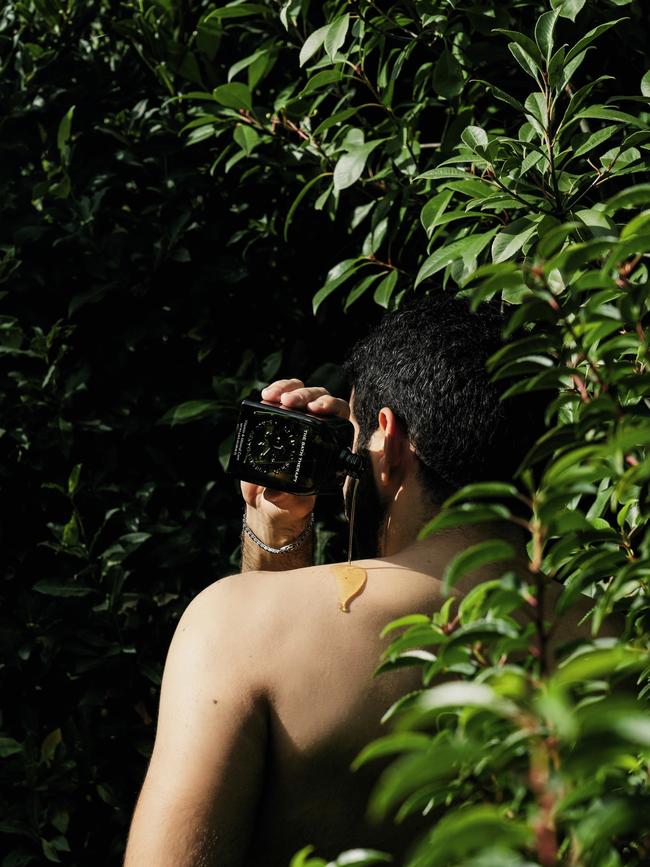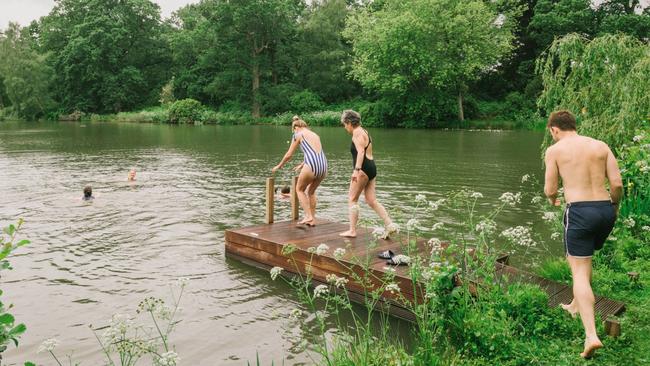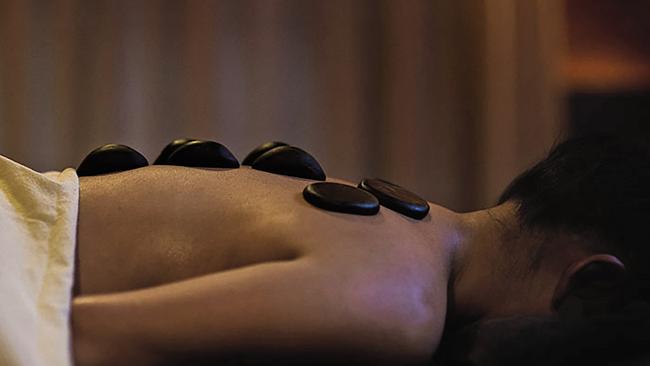‘Soil-to-soul’ wellness: the future of health retreats
A fresh crop of wellness retreats has sprouted with a focus on regenerative farms, nature experiences and plant-based fare.

If there was one epiphany that many of us experienced during Covid lockdowns it was this: nature can help us heal. That’s not just a slogan on a T-shirt; there’s plenty of science behind the age-old observation as well. Research shows that spending time in nature lowers blood pressure, reduces stress, strengthens our immune system and inspires creative thinking. To that end, in the past few years, forward-thinking resorts have started to invest in farms over golf courses, and now more and more of them are sowing their wellness programs on the land, threading medicinal plants, yoga pavilions and therapy tents in among the vegetable beds. A pioneer of elevated farmhouse hospitality is the Garden Spa at Babylonstoren in South Africa, where paths through trees and herbal gardens lead from one feel-good adventure to the next. Here are four of our like-minded favourites, ranging from Tuscany to Nepal.
Sterrekopje Healing Farm in South Africa’s Franschhoek Valley


At this sumptuously decorated manor house with 11 rooms, surrounded by 50 hectares of gardens and farmland, every guest is treated like a precious seed that’s meant to be nurtured and cocooned in the most fertile of earth. “We call this a soil-to-soul wellness experience,” says co-owner Fleur Huijskens who, along with her partner in business and life, Nicole Boekhoorn, spent two years designing and expanding the farm with the help of Leon Kluge, the resident “guardian of the soil”. That was before they even started conceiving the rooms. For Huijskens and Boekhoorn, rich soil and bountiful gardens are the essential foundation for a home, a retreat, a healthy life.
“Regeneration is about leaving one’s environment in a better place than when you found it,” says Huijskens. “That’s how we farm, but it’s also how we want to live.” At Sterrekopje, “There are no schedules or transactions here,” she continues, explaining that everything is one price and paid in advance. Instead, there’s wild swimming, hiking, landscape painting, ceremonies around a fire pit and meditation under the moon, as well as freshly pressed juices and tantalising plant-friendly meals made from the bounty of the farm. (Every day guests are encouraged to harvest produce from the garden with the chef.) Sterrekopje is not about a doctor giving you a prescription; it’s about allowing yourself the time to listen to your own body and mind, and indulging yourself – trying anything that feels right, from breath work to Indian head massages to hypnotherapy. “After a few days,” adds Huijskens, “you get out of your head and into your body, and when you are reconnected with your body, then it knows naturally what it needs.” sterrekopje.com
Borgo Santo Pietro in Tuscany


Centuries ago, the Borgo Santo Pietro was the site of a sanctuary near a 13th-century Gothic church and abbey where Christian pilgrims would stop for refuge on their way to Rome. Today, the hotel’s Danish owners, Claus and Jeanette Thottrup, who spent more than seven years transforming its ruins into an elegant stone manor house surrounded by 120-odd hectares of ornately manicured gardens and organic farmland, have created a luxurious 22-room retreat inspired by nature and ancient knowledge. Guests happily get lost in the maze of gardens on the way to the spa, immersed in the sounds of splashing water fountains, the singing of birds and the scent of roses. The spa itself is hidden in an expansive orchard of blossoming cherry and apple trees surrounded by a wall of perfectly manicured hedges. Tucked among the trees are several four-poster daybeds draped in translucent white fabric; massage appointments can take place here while the scent of lavender drifts by from the garden.
Jeanette Thottrup spent years working with a cosmetic scientist to create the spa’s exclusive Seed to Skin Tuscany products, with several ingredients sourced from the farm. These products have become so cultish that they are now used at some of the world’s most exclusive properties. More recently a workshop for tea and essential oil production has been built among two and a half hectares of herb and flower fields, so guests can learn to make both; there’s even an ice-cream parlour serving homemade artisanal gelato in the walnut fields and alfresco dinners served in the vegetable gardens three times a week. And, of course, the farm also supplies the resort’s two standout restaurants: Trattoria sull’Albero, an intimate dining room with a glassed-in kitchen built around a massive oak tree that serves traditional Italian dishes; and Saporium, the Borgo’s ambitious fine-dining restaurant, whose recently opened outpost in Florence has already won accolades. borgosantopietro.com
Heckfield Place in Hampshire, England

Years before Heckfield Place opened in 2019, its owner, the billionaire venture capitalist and philanthropist Gerald Chan, channelled much of his investment and focus on building up the gardens and expanding the farm within the estate’s 160 hectares of land. This legacy project is driven by his passion for regenerative agriculture, which means working with nature to improve soil health and lower greenhouse gas emissions. The food is both delicious and nutritious at Heckfield: award-winning Australian chef Skye Gyngell serves as culinary director at the property’s Marle and Hearth restaurants and Moon Bar. “Our regenerative practices are in the DNA of everything we do in the house and across the whole estate,” she says.
This is also true of its wellness philosophy. Heckfield took more than four years to build its spa, The Bothy by Wildsmith, a two-storey, 1580-square-metre building set within a walled garden that opened last April. There are no clocks (guests have to check in their phones), but plenty of serene spaces, including multiple treatment rooms, a library and an ionised chlorine-free pool with a view of oak trees and fields of wildflowers – it’s easy to lose all sense of time in this magical place. Many of the wellness practices at Heckfield take place outside – regardless of the season – in the forest and on the farm. Eco-psychologist Amy Steadman guides clients on therapeutic walks throughout the property, while Karolina Wierzbicka, Heckfield’s head of movement, leads bootcamp classes on the farm. Workout stations are scattered throughout the woodlands – meditation and yoga take place in an elegant pavilion overlooking a small grass-lined man-made lake, and sound-bath sessions are set under ancient oak trees. heckfieldplace.com
Dwarika’s Resort Dhulikhel in Nepal

Many regular travellers to Nepal know and love the atmospheric, elegant Dwarika’s, a historic Newari-style property with 80 rooms in Kathmandu, but few know that the same family have built a world-class spa resort about an hour’s drive east of the city. A passion project led by one of the matriarchs of the family, Sangita Shrestha Einhaus, the complex, built of natural materials including wood, stone and earth into the slope of a lush hillside, was designed around the trees. “When we were building, we never took a tree down; we only planted more,” says Shrestha. The family is just as dedicated to farming as they are to running hotels; they take food so seriously that they are driven to grow and raise everything that’s served in their restaurants. In fact, they own six farms at different altitudes throughout the country, two of which are on or near the Dhulikhel estate. It’s not just the food that’s harvested from their lands: all the products used in the spa and in the spacious suites, from oils and soaps to creams, are soil to skin, produced on site.
“We spent as much time, if not more, on the gardens and the landscaping as on the architecture,” says Shrestha. Healing plants grow throughout; a local kind of cactus, believed to cleanse a space of negative energy, surrounds the property. Paths wind through the jungle, leading from a guest suite to the spa complex to the Himalayan Salt Room to the lounge at the top of the hill with spectacular views. Along the way, guests might find a sacred grove or a mirror installed in an unexpected place. It’s to make guests contemplate their place in nature. “We want them to see themselves merging within the natural landscape,” explains Shrestha. Next year the resort will offer several new wellness adventures, including hikes to ancient Buddhist monasteries and to two of the resort’s farms. “Here you can do as much or as little as you like,” says Shrestha. dwarikas-dhulikhel.com

To join the conversation, please log in. Don't have an account? Register
Join the conversation, you are commenting as Logout